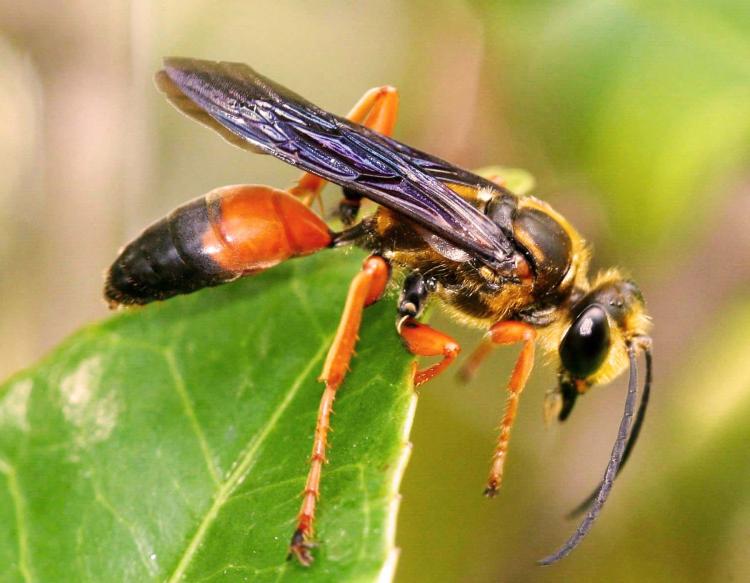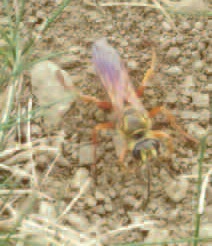SCORES & OUTDOORS: Wasps have a bad reputation: this one, though, is the gardener’s friend

Internet photo of a Great Golden Digger Wasp.
 by Roland D. Hallee
by Roland D. Hallee
A friend of mine was asked by an acquaintance if she recognized a certain bug she found hanging around the garden, and boring holes in the yard. My friend suggested the person send the photo to me for identification. With the help of my insider at the Maine Department of Inland Fisheries and Wildlife, Phillip deMaynadier, Ph.D., a wildlife biologist, with the wildlife research assesment section, it was identified

Photo taken by Sharon Carter of a Great Golden Digger Wasp.
The insect (see photo), is a Great Golden Digger Wasp, Sphex ichneumoneus. Despite its vivid, alarming coloration, the Great Golden Digger Wasp is not an aggressive species of the wasp.
The Great Golden Digger Wasp appears every June, and remains for the next couple of months, going through a methodical routine.
Unfortunately, social wasps like the yellow jackets and hornets give all wasps a bad name. Solitary wasps like the Great Golden Digger Wasp are virtually harmless. They do not guard their nests and are not aggressive towards humans. Females are equipped with stingers but use them only on their prey, although a rare sting to a human may occur if the wasp is grabbed or stepped on. Male wasps may act aggressively, but they have no stingers and can do no harm.
Unlike the social wasps, which live commune-style with a queen and non-reproducing minions that handle the hard labor, digger wasps are solitary creatures.
The Great Golden Digger Wasp measures more than an inch in length. They have a black head, orange and black body, orange legs, and iridescent amber wings. Short, golden hairs cover its head and thorax.
The first reaction of a gardener who confronts a large, intimidating-looking Great Golden Digger Wasp may be to grab a can of bug spray. Don’t do it! Not only are these bugs harmless to humans, they provide many benefits to the garden.
Adult wasps, both male and female, pollinate plants by feeding on flower nectar. Female wasps prey on grasshoppers and similar pests that otherwise cause a lot of damage to vegetable and ornamental plants in the garden. And by digging holes in the ground, the wasps help to aerate the soil and improve drainage.
The female wasp will spend her short life engaged in the methodical building and stocking of a half dozen or so nests.
When the wasp hunts, she stings her prey and releases paralyzing venom. She transports the paralyzed insect back to her nest by air – if it is light enough to fly with – or by dragging it across the ground by its antennas. On the way, she may have to fend off robins, sparrows, and other birds intent on stealing the insect from her. They only hunt members of the grasshopper family. They are great pollinators and should be welcome in your garden.
The female digs a chambered tunnel in open ground, and proceeds to stock it with food for her young to eat. She searches for insects, which usually includes crickets, katydids and grasshoppers. Then she goes through a ritual that is unique among insects. The prey is placed at the opening of the tunnel while she crawls inside to inspect it. Then, she comes back out and grabs the unlucky insect by the antennae and pulls it inside head-first. She has been genetically patterned to perform these motions, and if anything changes, she cannot complete this task.
If the prey insect is moved a few inches from where she left it, she will quickly locate it and pull it to the entrance. Once again she will go inside to inspect the burrow. This scene can be repeated time and time again, and she will perform the same acts. What looks like a thoughtful precaution, is simply genetically programmed into the species.
Should one of the antennae break off, she will usually leave her catch and go find another insect. She is not able to figure out that by grabbing it by a leg, she can accomplish the same thing. It’s either by the antennae or its move on to another prey.
Upon returning to the nest, the wasp drops her prey outside the entrance while she reopens and inspects the tunnel. She then drags her still-paralyzed victim to a nesting chamber, and lays one egg on top of it.
When she leaves the nest, she closes up the nesting chamber behind her. She will not return. Over the fall and winter, the wasp larva will undergo a complete metamorphosis. It will emerge in June as an adult and begin the process all over again. When the adult emerges from the underground nest where it hatched the previous summer, it has but one job to do: to reproduce.
Great Golden Digger Wasps can be found in North America, Mexico, Central and South America, and even the Caribbean.
So, if you’re lucky enough to encounter a Great Golden Digger Wasp in your garden, leave her alone. She’s working hard. Just step back and observe one of the most unique inhabitants in the garden.
Roland’s trivia question of the week:
In 1992, what Red Sox pitcher’s no-hitter against the Indians was rescinded by MLB because he only pitched eight innings as the losing pitcher on the road team?
Responsible journalism is hard work!
It is also expensive!
If you enjoy reading The Town Line and the good news we bring you each week, would you consider a donation to help us continue the work we’re doing?
The Town Line is a 501(c)(3) nonprofit private foundation, and all donations are tax deductible under the Internal Revenue Service code.
To help, please visit our online donation page or mail a check payable to The Town Line, PO Box 89, South China, ME 04358. Your contribution is appreciated!


Leave a Reply
Want to join the discussion?Feel free to contribute!